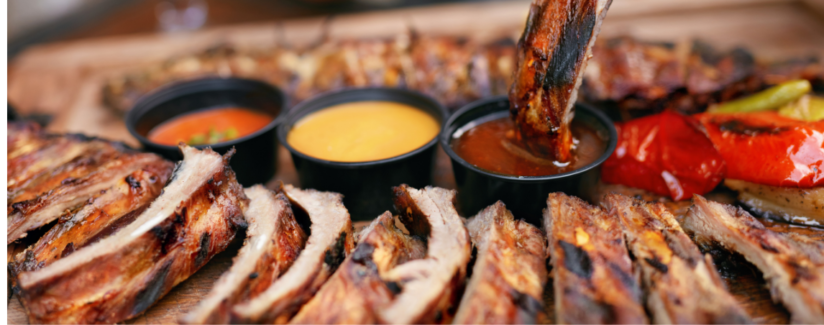
Nine Things to Know About Eating Meat
11/30/2020
Protein comes in many forms, with plant-based options now widely available. Some people choose meat for the flavor, texture or nutrition profile, while others are interested in alternatives.
Is eating meat healthy? What is the best form of protein?
Two dietitians helped answer our questions. Melissa Joy Dobbins, MS, RDN, CDE, is the host of the Sound Bites podcast and Kim Kirchherr, MS, RDN, LDN (IL), FAND, ACSM-CPT, President of K2 Outcomes LLC, specializes in the connection of agriculture, food, nutrition and health.
Here are some surprising things they shared about eating meat.
1.Meat can be part of a healthy diet.
Animal protein has long been an important food for humans and continues to be one.
Kirchherr: “Meat has played an important role in our menus for generations, before refrigeration was an option and before it was as efficient as it is now to transport and access food. Meat is an important nutrient-rich food all year, with different ways of preserving and storing it to keep it safe for us.”
Learn more in her recent blog.
2. Meat is more than protein.
The terms “meat” and “protein” are often used interchangeably, but meat provides many other nutrients.
Dobbins: “Beef is a nutrient-rich food that provides high-quality protein, iron, zinc, choline and B vitamins, which helps people avoid nutrient shortfalls throughout the lifespan, support healthy pregnancies and growth and development throughout childhood, maintain strength, energy and vitality into adulthood, and age vibrantly and independently.”
Kirchherr: “Meat is part of the protein group. It is a choice that provides a specific, wonderful matrix of nutrients. This includes bioavailable (easily absorbed) iron, zinc and Vitamin B12, to name a few.”
3. Animal protein is different than plant-based protein.
You can order a burger made from plants or a burger made from beef. They are not the same thing.
Dobbins: “It really depends on the specific product and comparison to determine which might be healthier. Many of the new plant-based burgers surprisingly have similar nutrition profiles as regular burgers.”
Kirchherr: “In a most basic and fundamental comparison, animal sources of protein are considered a high-quality protein because they provide all the essential amino acids we need in one food. Plant proteins need to be specifically chosen to ensure that you cover all the essential amino acids, because a majority of them do not have all of them in one food.
“Another consideration is that plant sources of protein can be a source of fiber, while protein from meat offers iron that is more readily available to us and vitamin B12. Plant foods typically contain carbohydrates, while animal proteins do not. Type and amount of fat can vary in both, as can sodium – especially when we consider the preparation and cooking techniques of prepared and fresh choices.”
4. You’re probably not eating too much protein.
We sometimes hear that Americans have too much protein in their diet. For most of us, that’s not a concern.
Dobbins: “On average, people are eating about the same amount of protein recommended in the Dietary Guidelines for Americans. The guidelines recommend 5.5 ounces of lean protein per day and the average intake, according to CDC data, is around 4.6 ounces per day, which includes about 1.5 ounces of beef per day.”
5. Lean meat options abound.
Concerns about fat or cholesterol have caused some people to cut down on animal protein. Good news for meat lovers is that healthy options continue to increase.
Dobbins: “Beef is leaner today than ever before, making it easier for Americans to include lean beef in a variety of healthy diet patterns. More than 65 percent of beef cuts available at the grocery store are considered ‘lean’ based on USDA standards. In addition, 17 of the top 25 most popular beef cuts sold are ‘lean.’”
Kirchherr: “One of my favorite tips for efficient, informed shopping is to look for the word ‘loin’ or ‘round’ in the name to choose a leaner cut of meat. Pork tenderloin, for example, is an easy to cook, flavorful choice to make.”
6. With a little planning, meat dishes can be easy and economical to prepare.
Does cooking traditional meat seem overwhelming? It’s easier than you might think. Our experts share some advice for making your favorite meats at home, even on the busiest of days.
Kirchherr: “In terms of shopping, planning ahead can make future meals easier and more efficient. If you are buying a roast, chicken or turkey, buy one that’s bigger than you need so you have extras to freeze. You can make soup from the bones, and the possibilities for fast meals and snacks later are nearly endless.
“Sandwiches, casseroles, skillet meals – so many great ways to use that ready-to-eat, delicious meat or poultry that you have already prepared. You can make it easier by freezing amounts that are pre-portioned for recipes. Buying value packs is another great shopping tip, even for smaller households. Take a moment to repackage these into meal-sized bundles and pop them in the freezer. It’s a great way to save money and have built-in portion control, too.”
7. Producing meat can be sustainable for the environment.
Concern about greenhouse gases has prompted interest in plant-based proteins. Learning more about modern farming can help you make a more informed decision.
Dobbins: “While all types of agriculture, not just animal agriculture, have an impact on the environment, it’s much lower than is often portrayed by celebrities and other groups. According to 2018 EPA data, beef cattle directly account for 2 percent of greenhouse gas emissions, and all of agriculture (crop and animal) accounts for 10 percent of greenhouse gas emissions compared to much higher emissions from transportation (28 percent), electricity (27 percent) and other sources.”
8. Variety in your diet is important for several reasons.
A balanced diet includes animal protein, as well as fruits, vegetables, grains and dairy.
Kirchherr: “Consider meals from a visual and taste perspective. Menus that include a variety of food groups during the day are interesting to look at and provide the chance to include different textures and temperatures, too, which can make meals more fun. The nutrition bonus? Different foods often help each other out in terms of nutrition absorption. Vitamin C helps with iron absorption, and fat helps with fat-soluble vitamins. From a digestion and availability perspective, there is a great amount of work that happens in our digestive tracts. From a meal planning and taste perspective, all we need to remember to get this done is to eat and enjoy a variety of foods.
“No matter your budget or personal taste preferences, planning meals that include variety will help deliver the nutrients we need and the different flavors we crave.”
9. You don’t have to feel guilty about enjoying meat.
Dobbins: “You can continue to include and enjoy lean beef as part of a diet that’s healthy for you and healthy for the planet.”
Meat adds important nutrients as well as variety to the diet. Pork, beef, chicken and turkey all provide lean choices that can be prepared in different ways to provide nutrient-rich protein filled with flavor that pairs well with all the other food groups.



























